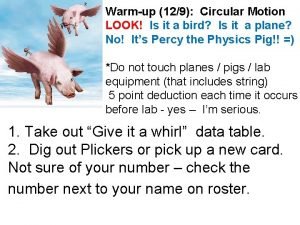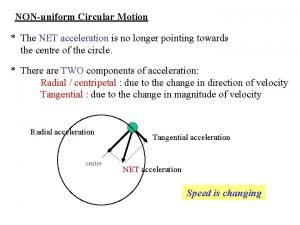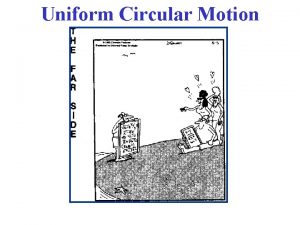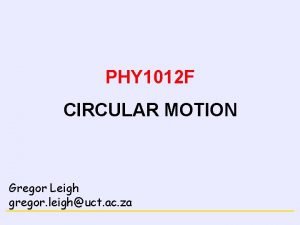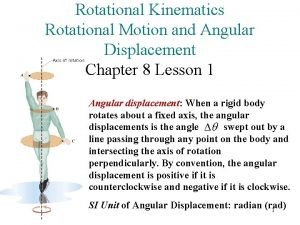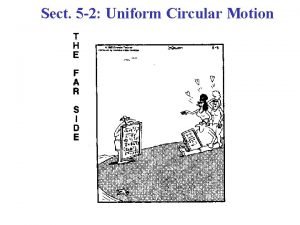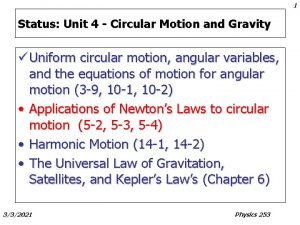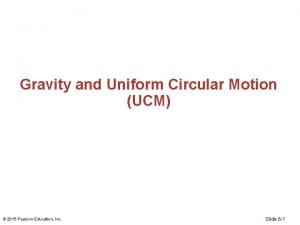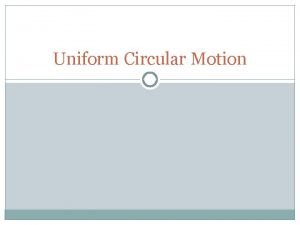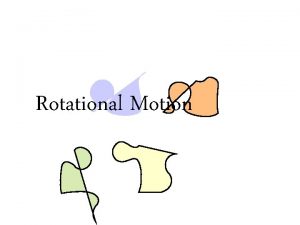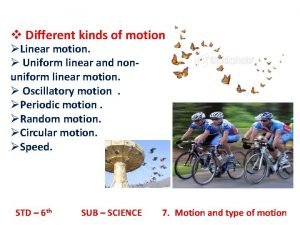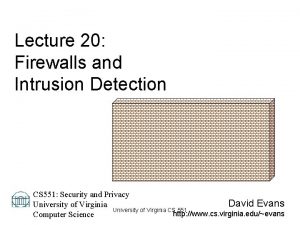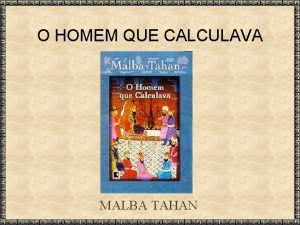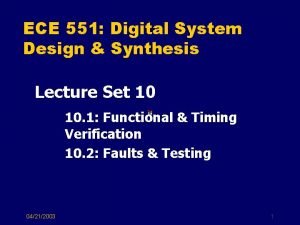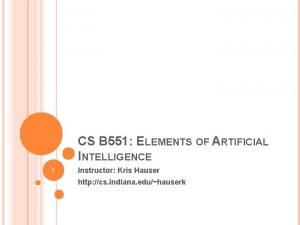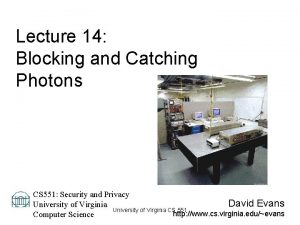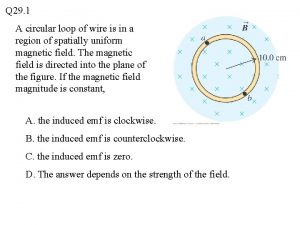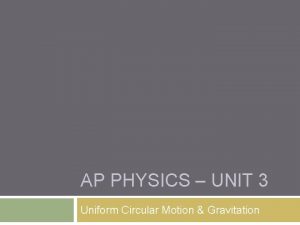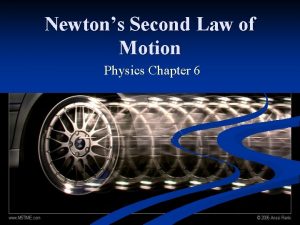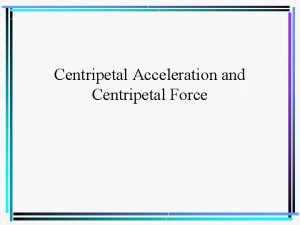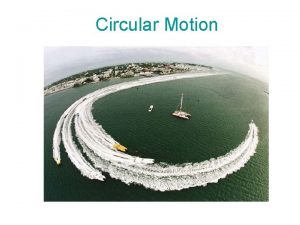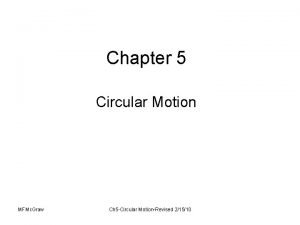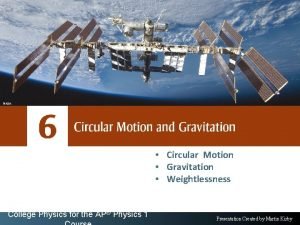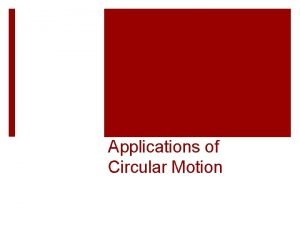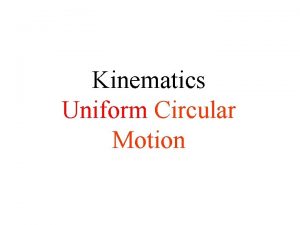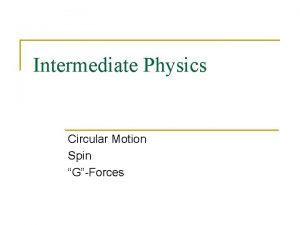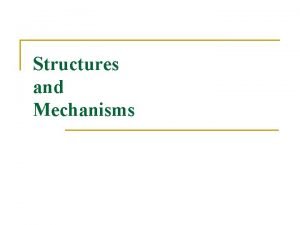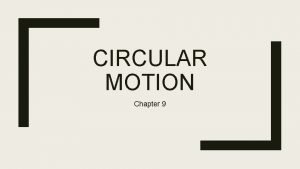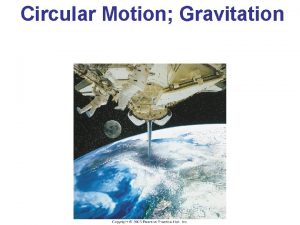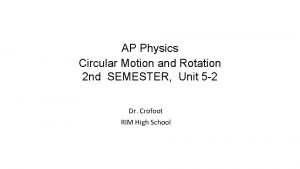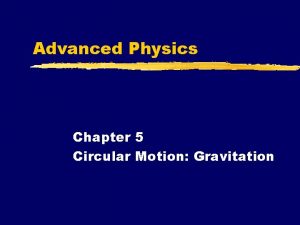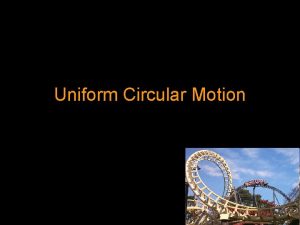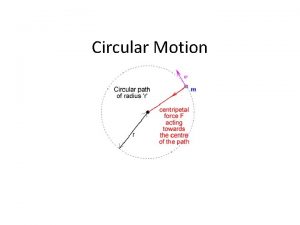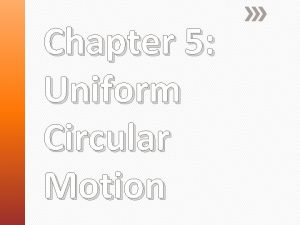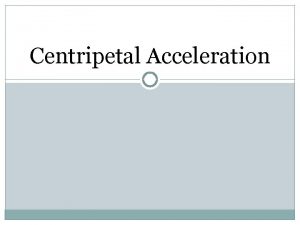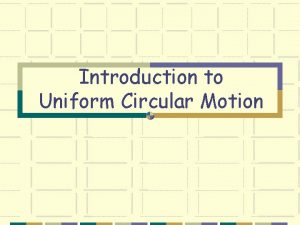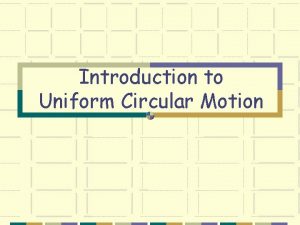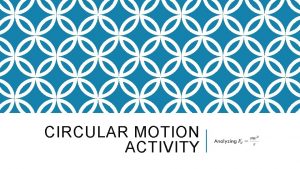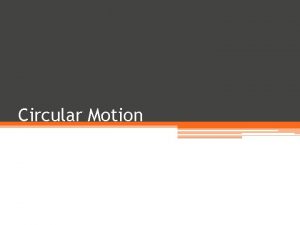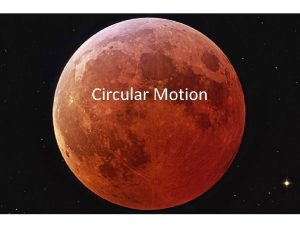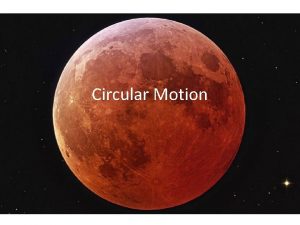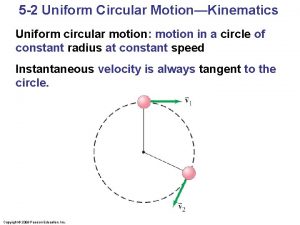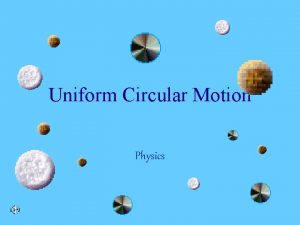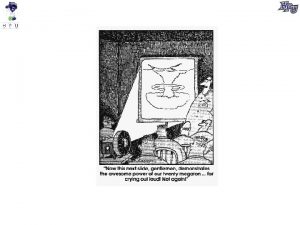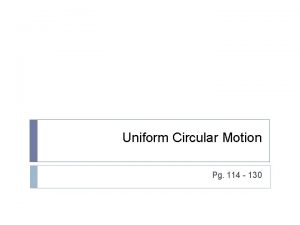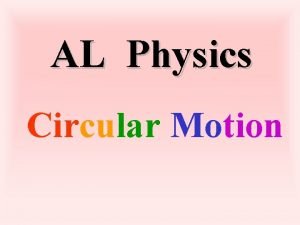11 2 Uniform Circular Motion pg 551 Uniform











































- Slides: 43

11. 2 Uniform Circular Motion pg 551

Uniform Circular Motion When an object is moving in a circle and its speed (the magnitude of its velocity) is constant, it is said to be moving with uniform circular motion. The direction of the objects velocity is always tangent to the circle (hence at the exhibition, when going around in the crazy swirly ride, your body wants to fly out of the ride. When you drive around the roundabout, your body (and car) also want to fly out the side Centripetal Acceleration – the centre directed acceleration of a body moving continuously along a circular path.



If a comet has a radius of 20 meters, and a satellite orbits it every 3 minutes, what velocity is the satellite orbiting at? What would be the centripetal force?

Centripetal Acceleration formula is ac= V 2/r ac = centripetal acceleration in m/s 2 V= velocity (or magnitude) in m/s R = radius of the circle (m)

Centripetal Force Is the force that causes centripetal acceleration http: //www. youtube. com/watch? v=GM_2 Ceh 05 Gs&featu re=relmfu Formula is Fc = mv 2 / r Fc = centripetal force (N) M = mass in kg V = velocity in m/s R = radius of circular path (m) Fc = Fn Fn = Ff (if at a constant speed)

A yo yo has a mass of 225 g. The full length of the string is 1. 2 m. You decide to see you slowly you can swing it in a vertical circile while keeping the string fully extended, even when the yo yo is at the top of its swing. a) Calculate the minimum speed at which you can swing th yo yo while keeping it on a circular path b)At the speed in a, find the tension in the string when the yo yo is at the side and at the bottom of its swing. a) To swing the yo yo to keep it on a circular path, you have to swing it just above the force of gravity. Therefore Fg=Fc Fg = Fc mg = mv 2 / r Solve for v v 2 = gr V = 3. 4 m/s

A yo yo has a mass of 225 g. The full length of the string is 1. 2 m. You decide to see you slowly you can swing it in a vertical circile while keeping the string fully extended, even when the yo yo is at the top of its swing. ·Calculate the minimum speed at which you can swing th yo yo while keeping it on a circular path ·At the speed in a, find the tension in the string when the yo yo is at the side and at the bottom of its swing. b) At the speed in a, find the tension in the string at the side at the bottom At the side Fc = Ft Ft = mv 2 /r Ft = 2. 2 At the bottom Fc = Fc + Fg Ft = mv 2 / r + fg Ft =. 2 kg(3. 431)2 / 1. 2 m +. 2*9. 81 Ft = 4. 1 N Fc Fg At the top subtract Fg Fc =. 238 N

With your partner, decide with what minimum velocity you would need to spin one of yourselves with a string a). 2 meters long b) 10 meters long Then determine with what the tension in the string would be at the top bottom right and left side

A string used to make a pendulum has a breaking strenght of 14 N and a length of 1. 2 m. A 2. 00 kg mass is used as a bob and set in motion. a) if the bob moves with a speed of 3. 0 m/s at the bottom of the swing, will the swing break? b) What is the max speed the bob can go so the string does not break (at the bottom of the swing) c) What is the max speed the bob can go so the string does not break (at the top of the swing)

A string used to make a pendulum has a breaking strenght of 12 N and a length of. 8 m. A 1. 00 kg mass is used as a bob and set in motion. a) if the bob moves with a speed of 1. 0 m/s at the bottom of the swing, will the swing break? b) What is the max speed the bob can go so the string does not break (at the bottom of the swing) c) What is the max speed the bob can go so the string does not break (at the top of the swing)

A car with a mass of 2135 kg is rounding a roundabout on a level road. If the radius of the curvature of the road is 52 m and the coefficient of friction between the tires and the road is. 70, what is the maximum speed at which the car can make the curve without skidding off the road? Fc = mv 2 / r Fc = Fn = Ff (if at a constant speed) Fn = mv 2 / r u. Fn = mv 2 / r. 7(2135)(9. 8)= 2135(v 2 ) /52 v = 19 m/s To remain on the roundabout the car must not go faster than 19 m/s.

Determine the mass of a car of someone in the class. How fast can you go around the roundabout in Charlottetown if the radius of the roundabout is 20 meters and the friction between the tires and the road is. 65?

Centripetal Force vs Centrifugal Force Every force needs an equal and Opposite force…hence Centripetal force = centrifugal force Fictitious forces, like centrifugal Forces, are needed to explain motion in non inertial frames of reference. http: //www. youtube. com/watch? v=fmf 2 n. Puv 2 OI http: //www. youtube. com/watch? v=h. ZOek. FFSo WI

In a celtic field event called the hammer throw, a 12 kg ball is whirled in a circle of radius 2. 0 m with a frequency of 1. 5 Hz. a) What is the velocity when it is released? b) What is the centripetal force?


Chapter 12 Universal Gravitation pg 572 -594 5 classes ically, universal gravitation states that all objects are attracted toward eachother…causing gravity. The lighter object is always attracted toward the heavier object. The distance between these objects decreases the strength of gravity. Bas

Kepler, was the guy who discovered three key concepts when discussing the motion of planets Kepler's 3 Laws ·Planets move in elliptical orbits, with the Sun at one focus of the ellipse ·An imaginary line between the Sun and a planet sweeps out equal areas in equal time intervals. ·The quotient of the square of the period of a planets revolution around the sun and the cube of the average distance from the sun is constant and the same for all planets. The area of the shaded regions is the same. Therefore a planet has to move faster on the left side of the sun than the right In the case with Earth, the left side corresponds to our winter and the right to our summer. Notice that the months in the year are longer in May-Aug and shorter In Nov through Jan http: //www. youtube. com/watch? v=Ni. WK 5 z 7 z_Oc&feature=related

Kepler's Third Law : The quotient of the square of the period of a planets revolution around the sun and the cube of the average distance from the sun is constant and the same for all planets. This constant is the formula r 3 =k T 2 is the radius and T is period (time it takes to go one full rotation) k is the constant r If you are comparing two planets, than r 3=k T 2 p: //www. youtube. com/watch? v=WTJa 8 DXlerc http: //www. youtube. com/watch? v=NG 18 f. Obq. MV 4&feature=relat ed htt

The orbital period and radius for Jupiter is 4332. 62 days and 5. 2 AU respectively. Calculate Saturn's radius if the orbital period for Saturn is 10 759. 2 days. r 3=k T 2

Newton’s Universal Law of Gravitation F = force of gravity M 1 = first mass (the bigger mass) M 2 = second mass G = universal gravitational constant R = distance between the centre of the masses G = 6. 67+10 -11

A 65 kg astronaut is walking on the surface of the moon, which has a mean radius of 1. 74*103 km and a mass of 7. 35*1022 kg. What is the weight of the astronaut? B/c I’ve forgotten what gravity is on the moon, we can’t use F =mg rather we use Fg = G (m 1 m 2) r 2 Fg =6. 67 *10 -11 * (7. 35* 1022)(65) (1. 74*106)2 Fg = 105 N (this is the weight of the astronaut) Now, determine how much gravity is on the moon F = mg 105 = 65(g) 1. 61=g

Now that we've done the moon, a 65 kg astronaut is walking on the surface of the Saturn, which has a mean radius of 6*104 km and a mass of 5. 6851 × 1026 kg. What is the weight of the astronaut?

Looking at your partner, determine your mass and distance between each other. Now, calculate the a)force between you b)gravity between you (to calculate gravity, use only one person's mass)

Page 580 Questions # 16 use appendix B pg 955

Notice Newton’s Law of Universal Gravitation looks a lot like the centripetal force equation Fc = mv 2 / r The two forces are equal ! Therefore mv 2 = G (m 1 m 2) r r 2 I were to solve for velocity V = √(Gm) /r If

The general formula that combines Kepler’s third law and Newton’s Law of Universal Gravitation, is mv 2 = G (m 1 m 2) r r 2 W hich can be rearranged into R 3 = Gm T 2 4π 2 en do I use which? ? ? …it depends upon what variables I have. To utilize this law, Wh

Find the mass of the sun, using Earth’s orbital radius and period of revolution (use page 955 to help you) G = 6. 67* 10 -11 T = 365. 25 days = 3. 1558* 107 seconds R = 1. 49 * 1011 Using the formula, what are we looking for…. m R 3 = Gm T 2 4π 2 = R 3 *4π 2 T 2 * G Fill in your numbers and M = 1. 97* 10 30 kg M Now use Venus and Mercury to find the mass of the sun. (use page 95 to help you)

The period of the moons orbit is 27. 3 day. If the mean radius of moons orbit is 3. 84 * 108 m, calculate the mass of Earth? M = R 3 *4π 2 T 2 * G

How fast is a satellite orbiting Earth if it is 200 km from the surface of the Earth? mv 2 = G (m 1 m 2) r r 2 V = √(Gm) /r V = √(6. 67* 10 -11 )(5. 98*1024 )/200000 meters V=

R = Gm 2 2 T 4π can be flipped for easy switching to 2 2 T = 4π R 3 Gm 3 Remember, all your units have to be in seconds and meters ! Page 586 Questions 9 -14

12. 2 Planetary and Satellite Motion Page 587 As Earth is a circle, if you can maintain a strong enough speed, you should be able to stay in the atmosphere forever. The reasoning, is that if you can match your decent (downwards), to match the curvature of the earth (4. 9 meters every 8 km), you can stay in the air permanently. Formula for Period .

Formula’s R 3 = Gm T 2 4π2 o r Fc = Universal law of gravitation mv 2 = G (m 1 m 2) r r 2 Wh ich m cancels out? (the m that is rotating around) V = √(Gm) r or T = 2π √ R 3/Gm or T = 1/f Formula for radius, if you do not use one of the formula’s fr up above R = v. T 2π

1) At satellite orbits earth at an altitude of 200 km. What is its orbital speed? 2) What is the satellite's period? 3)If you want a geosyncrohnise orbit, what would be your radius ?

1) At satellite orbits earth at an altitude of 200 km. What is its orbital speed? V = √(Gm) r 2) What is the satellite's period? T = 2π √ R 3/Gm 3)If you want a geosyncrohnise orbit, what would be your radius ?

The problem on Earth is air friction. If though, you go high enough in the air (outer layers of atmosphere), the friction caused by air decreases enough that a geostationary orbit can be achieved If you go farther out still, you can go at a speed that is identical to earths rotation, resulting in a geosynchronous orbit. A satellite that is in geosynchronous orbit is still falling toward earth…its just falling at the same speed that Earth is moving away…meaning it never catches up or slows down.

The planet Uranus has an orbital radius around the Sun of about 2. 3 * 108 m. What is its period & orbital speed? T=? G = 6. 67* 10 -11 M of Uranus = 9. 98* 10 24 kg Radius of Uranus = 6. 38 * 106 ss of Sun =1. 99*1030 F ormula for velocity Ma V = √(Gm) /r T = 2π √ R 3/Gm

Review Questions 1)Two masses 4. 0 kg and 8. 0 kg, are located 2 m apart. What is the gravitational attraction force between them. 2) What is the mass of an object which experiences a pull of 10 N at the Earth's surface? 3)At what height above the earth's surface would an objects weight be one half the value at the surface?

Review Questions Two masses 4. 0 kg and 8. 0 kg, are located 2 m apart. What is the gravitational attraction force between them. Fg = G (m 1 m 2) r 2 t is the mass of an object which experiences a pull of 10 N at the Earth's surface? Wha 10 g = g(m 1 m 2) r 2 what height above the earth's surface would an objects weight be one half the value at the surface? At Fg = G (m 1 m 2) r 2 F Fg = 6. 67*10 -11 (5. 98*1024)(90) (6. 38*106)2 g = 881= weight 440 = 6. 67*10 (5. 98*10 )(90) r 2 r = 9 * 106 meters S ubtract this new r from the radius of earth and you get 2. 6*106 meters -11 24

At what position between the Earth and the moon would a spaceship experience no net force? This is where the centripetal force = the force of gravity mv^2/r = GMm m/r^2

Microgravity Even though astronauts in the space ship are floating, they still experience gravity. In fact, gravity is still fairly strong (Earth’s gravity is strong enough to keep the moon in orbit) Hence apparent weighlessness experienced by astronauts is called microgravity. There still is gravity. . . and they are still falling towards the center of the Earth…but because they are so far away and Earth is moving so fast…there falling never quite catches up to Earth’s movement. If I were to drop an apple in the spaceshuttle, it would be in a free fall towards earth…but it would appear to float

Page 591 Questions 1517
 Centripetal acceleration symbol
Centripetal acceleration symbol Net acceleration in circular motion
Net acceleration in circular motion How are uniform circular motion maps
How are uniform circular motion maps What is uniform circular motion
What is uniform circular motion Non uniform circular motion
Non uniform circular motion Si unit of angular velocity
Si unit of angular velocity Definition of uniform circular motion
Definition of uniform circular motion Non uniform circular motion
Non uniform circular motion A physics textbook swings back and forth as a pendulum
A physics textbook swings back and forth as a pendulum E you
E you Time formula in circular motion
Time formula in circular motion Dynamics of uniform circular motion
Dynamics of uniform circular motion Uniform and non uniform linear motion
Uniform and non uniform linear motion Cs 551
Cs 551 Ak-pc 551
Ak-pc 551 Ece 551
Ece 551 O homem que calculava malba tahan
O homem que calculava malba tahan I 551 number
I 551 number Number 551
Number 551 Ece 551
Ece 551 Eu avisto uma terra feliz numero
Eu avisto uma terra feliz numero Csci-b 551 elements of artificial intelligence
Csci-b 551 elements of artificial intelligence Cs 551
Cs 551 725 hangi onluğa yuvarlanır
725 hangi onluğa yuvarlanır What are the 5 elements of hair design
What are the 5 elements of hair design A circular loop of wire and a long straight wire
A circular loop of wire and a long straight wire Circular motion conceptual questions
Circular motion conceptual questions Ap physics unit 3 circular motion and gravitation
Ap physics unit 3 circular motion and gravitation Newton's second law of circular motion
Newton's second law of circular motion Vertical centripetal force
Vertical centripetal force Circular motion examples
Circular motion examples Circular motion
Circular motion Martin kirby physics
Martin kirby physics Applications of circular motion
Applications of circular motion Circular motion
Circular motion A circular motion is one dimensional
A circular motion is one dimensional Circular motion
Circular motion Structures and mechanisms
Structures and mechanisms State of rest and motion
State of rest and motion Example of circular motion
Example of circular motion Curvilinear motion
Curvilinear motion Food prep terms
Food prep terms Ap physics circular motion
Ap physics circular motion Chapter 5 circular motion gravitation
Chapter 5 circular motion gravitation
